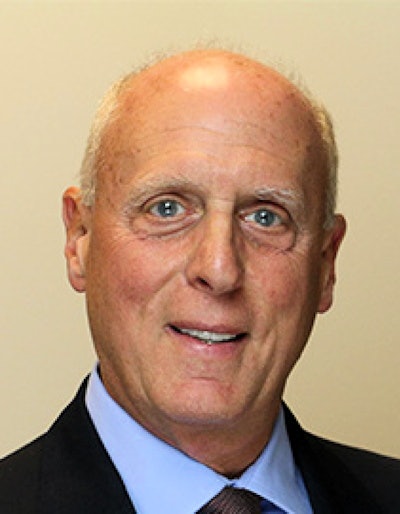
Over my 35 years practicing clinical radiology, I have been fortunate to have had many careers without changing employers, learning new skills and concepts, and, hopefully, making positive contributions in each endeavor. These included leadership roles in an innovative practice and radiology department; the growth of which was fueled by technology developed both outside of and within our practice; and in the American College of Radiology (ACR), where I have had the opportunity to network with and learn from so many smart people with diverse perspectives and participate in leading our specialty though waves of change.
 Dr. Alan Kaye.
Dr. Alan Kaye.A long-time advocate for increased role of radiologists in technology development and implementation, and now retired from clinical practice, I have embarked on another, exciting career working with bright, young data scientists, engineers, and other professionals to start a company which will leverage technology to support and enhance the role of imaging and radiologists in the continuum of care.
In my presidential address at the ACR annual meeting in 2018, I talked about the ambivalence within our specialty regarding the latest wave of technological change. In the three years since, as I reflect on the evolution of artificial intelligence (AI) and machine learning (ML) in radiology, I would like to share with you the notion that we are underemphasizing an important role for technology in enabling us to make even greater contributions to patient care and achieve more satisfying careers.
Radiology has historically attracted the best and brightest medical students. Many entered this demanding field to become consultants to treating physicians, helping them take the best care of our mutual patients. This incomparable role of being a "doctor's doctor" brought us the commensurate satisfaction that comes from "doing well by doing good."
I have witnessed PACS revolutionize not only the practice of radiology but also some of its deleterious effects on radiologists' job satisfaction and recruitment to the field. The volume and complexity of imaging studies have increased exponentially, while the number of new radiologists entering the field has not kept pace.
A compensation paradigm linked to productivity measures has compounded the stresses on radiologists and their practices and departments. As a result, job satisfaction has declined, with recent surveys reporting burnout rates ranging from 60% to 78%. Both factors likely contribute to the lower interest in radiology among medical students and the lower numbers of students who actually enter the field, which only exacerbates the pressures.
Unfortunately, novel technological developments, including so-called AI, have paradoxically added to these pressures on radiologists and all physicians. Largely overlooked until recently is the potential for AI/machine learning and technology to make the radiologist's job easier and enable us to become more efficient, more engaged, and better doctors.
How technology contributed to the problem
Radiologists are constantly dealing with technological issues, interruptions, and repetitive, clerical tasks that distract us from the most critical part of our work: reading and interpreting images. Three examples of this follow:
First, technology has pushed the boundaries in the complexity, acquisition, and display of examinations, a byproduct of which could be called information overload. The number of images radiologists must view for a typical CT study has increased from 50-100 to thousands -- amplifying the stressors on radiologists.
Different imaging modalities and presentation modes offer up unanticipated, supplemental, and frequently important information for the radiologist to consider, e.g., the biomarkers of coronary calcification that are indicative of cardiovascular disease.
The deluge of data poses a conundrum for dedicated doctors: Who wouldn't want access to all of this information if it can benefit the patient? Yet that additional information can be so broad and dense that searching through the chaff to find the wheat becomes a burden and a distraction. As the late Nobel laureate Herbert A. Simon wrote in 1971, "A wealth of information creates a poverty of attention."
Second, technology has imposed new tools on radiologists that are meant to ease the job but have actually made it more difficult, such as voice recognition software to speed reporting. Prior to the introduction of this software, I had a human transcriptionist who listened to my recorded findings and understood my language in context: inconsistencies between "left" and "right"; a word that sounds like "banana" doesn't make sense in the context of my reading and interpreting images; "negative" was a single word command to issue a normal report.
Conversion to voice recognition forced me to pay closer, real-time attention to the product of my dictation -- diverting me from the images -- then proofread the whole report myself; and there was no option for a "one-click" normal report. It created more work for me, not less, when it could have been done by a lower paid employee. Can you imagine this being tolerated in other industries?
Third, the key components of the workflow -- worklist, viewer, and reporter -- are siloed and inherently noninteroperable, which places a cognitive burden on radiologists to keep it all functioning. This burden could be relieved by integrating the components into a single system. However, even those legacy vendors that are highly supportive of radiology practices are not well-positioned to accomplish this "unification" for their customers.
AI has tremendous potential to relieve radiologists of these distractions, pressures, and burdens. But this potential has been underemphasized and largely neglected in favor of applying AI to the "sexier" use case of detecting abnormalities.
How technology can help solve the problem
AI is appealing for its potential to organize this volume of data and to handle many of the rote tasks radiologists currently must perform. Legacy vendors are unable to leverage AI for the radiology workflow because they face the classic "innovator's dilemma." They're entrenched in their models, and it would cost them too much to change.
The examples above, and many more, leave the space ripe for disruption with innovative technology that reduces the need for us, as radiologists, to spend time and mental energy on things that do not contribute to patient care. The right kind of technology can enable us to be the best physicians we can be by letting us stay focused on reading images and making diagnoses, increasing the effectiveness of our communication across the healthcare continuum, and enhancing our role in patient care.
In short, as AI strives to deliver on its promises for image detection, we must also recognize that improving the provider's experience is part of the Quadruple Aim of value-based healthcare. Technology can help achieve this by making radiology more rewarding for the radiologist. The result would be improved patient outcomes, increased job satisfaction, and more attractive career prospects for medical students.
Dr. Alan Kaye has broad leadership experience in many facets of radiology and healthcare. He is a past president of the American College of Radiology after having served on several ACR commissions, including economics, government relations, information technology, and the Future Trends Committee. Kaye served as president and CEO of a high-growth private radiology practice in Connecticut, and has held leadership positions at a large community hospital, residency program, multispecialty physician organization, and national health insurer advisory panels. He has been an appointee to numerous Connecticut state healthcare task forces, committees, and advisory panels. He is currently chief medical officer at Sirona Medical, the developer of the RadOS software.
The comments and observations expressed are those of the author and do not necessarily reflect the opinions of AuntMinnie.com.



















